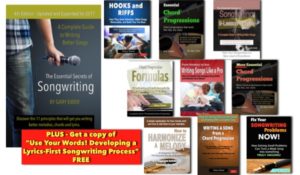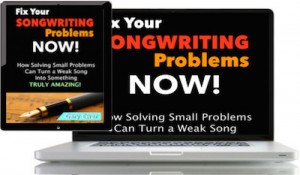When you read a lyric sheet, it may not occur to you that the best lyrics move back and forth between words and phrases that are observational and narrative, to words and phrases that display emotion.
 Thousands of songwriters are using “The Essential Secrets of Songwriting 10-eBook Bundle” to improve their songwriting technique. Become the most consistent songwriter you can be!
Thousands of songwriters are using “The Essential Secrets of Songwriting 10-eBook Bundle” to improve their songwriting technique. Become the most consistent songwriter you can be!
That back-and-forth characteristic of song lyrics is often a key element in pulling in an audience and keeping them wanting to listen. On a graph, a typical approach to the lyric might look like this:

In this graph, the narrative quality of the lyric is represented by the green line, while the emotional value of the lyric is represented by the green line. As you can see, they usually move in opposite directions.
Not every song will do this, and that’s because songwriting is an art form, meaning that we must also take into account the creative imagination of the writer, who might feel compelled to do something entirely different.
But take a classic rock/pop song like Lennon & McCartney’s “She Loves You”, and you’ll see that it represents their lyrical approach quite accurately. And even though “She Loves You” doesn’t use a bridge, you can eliminate that part of the graph and it still works. The verses tell a kind of story (“You think you’ve lost your love/ Well I saw her yesterday…”), and the chorus becomes considerably more emotional (“She loves you, yeah, yeah, yeah…”).
The ebb-and-flow of emotion within a lyric is part of what keeps audiences coming back. Songs that are all-emotion-all-the-time tend to dull their own effect. Audiences can become emotionally tired, you might say. They need the narrative quality of the verse to fuel the emotion of the chorus.
Creating Your Own Emotion Graph
Here’s a good idea for seeing how you’ve handled the emotional content of your own lyric:
- Take your latest song, and write out the lyric.
- Go line by line, and assess them for their emotional value. Assign a number out of 10. (1 is a purely observational, narrative line (“I was walking down the street..”), while 10 would be full-out emotion (“Oh, why, why why!?”)
- You can now go line by line and assess them for their narrative quality, but you should be noticing that fully emotive lines will have little narrative characteristic, while a purely observational line will have little emotion. As I mentioned, they tend to move in opposite directions.
- Draw a vertical and horizontal line graph like the one pictured above, label the verses and choruses and any other sections your particular song might have, and plot the emotion numbers by drawing a dot to represent the value of each line of lyric. If you assigned a line an emotional value of 2, let’s say, you place your dot down near the horizontal line. A 10 would put it at the top of the graph. Then draw a line to connect the dots.
- Do the same for the narrative characteristics. To make it clear, you may want to choose different colours for each quality, as the graph above has done.
You’ve now got a graph that shows the emotional and narrative qualities of your lyric at a glance.
The most common problem in this aspect of lyric-writing is when the verse contains too many highly emotive lines, with little narrative content. It’s usually a problem because without the narrative lines, the emotions of the chorus don’t seem to have a reason for being there, and the song just starts to sound “complainy.”
An exercise like this can be very instructional if you find that your lyrics aren’t having the kind of effect you want them to have. If you feel that something’s preventing your listeners from connecting emotionally to your lyric, this is a good first step for analyzing the problem.
 Written by Gary Ewer. Follow Gary on Twitter
Written by Gary Ewer. Follow Gary on Twitter
 “Fix Your Songwriting Problems – NOW!” puts the magnifying glass on 7 typical errors in the developing songwriter’s technique, and offers suggestions for solving the problems and moving forward. It’s part of “The Essential Secrets of Songwriting 10-eBook Bundle.
“Fix Your Songwriting Problems – NOW!” puts the magnifying glass on 7 typical errors in the developing songwriter’s technique, and offers suggestions for solving the problems and moving forward. It’s part of “The Essential Secrets of Songwriting 10-eBook Bundle.










